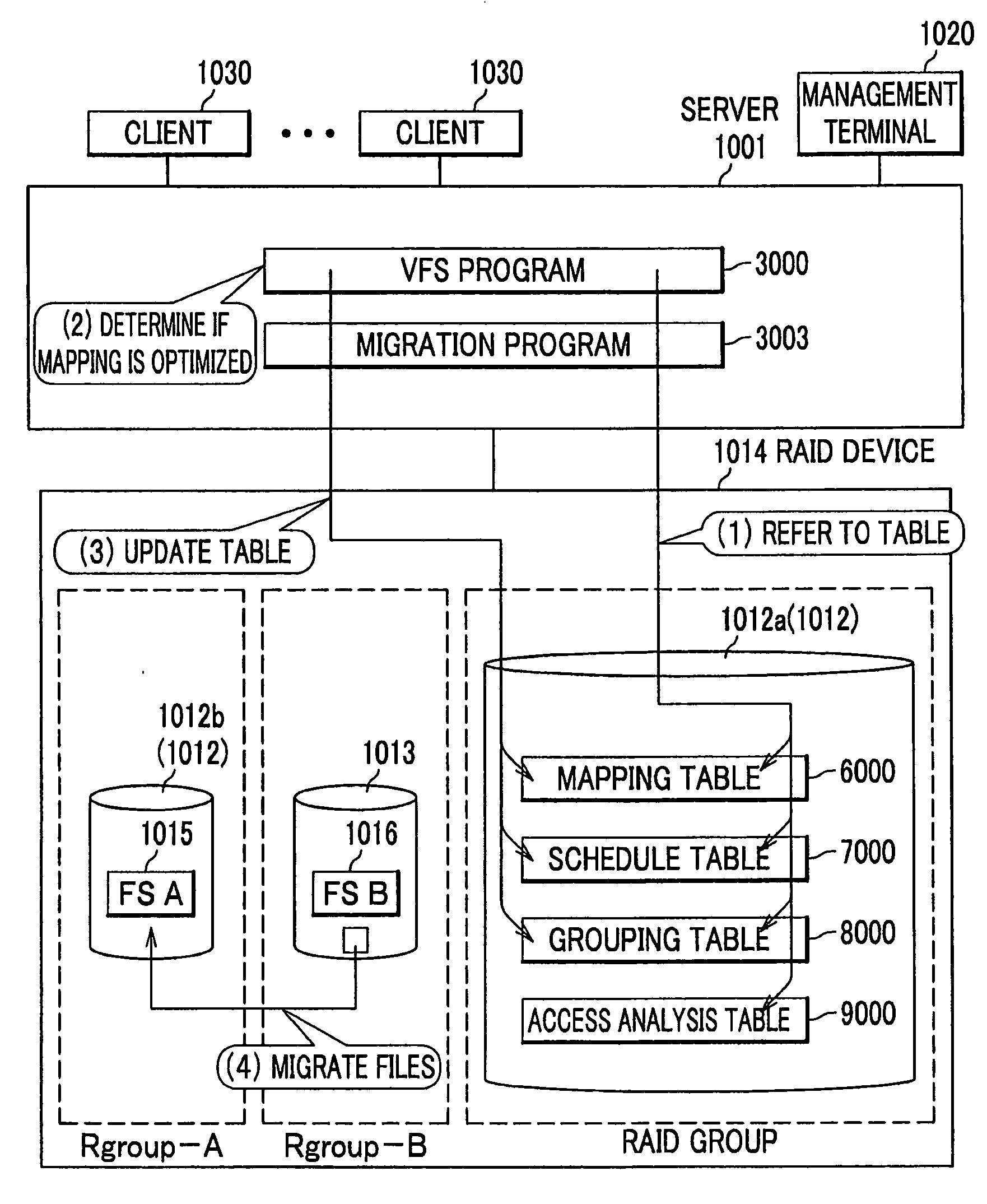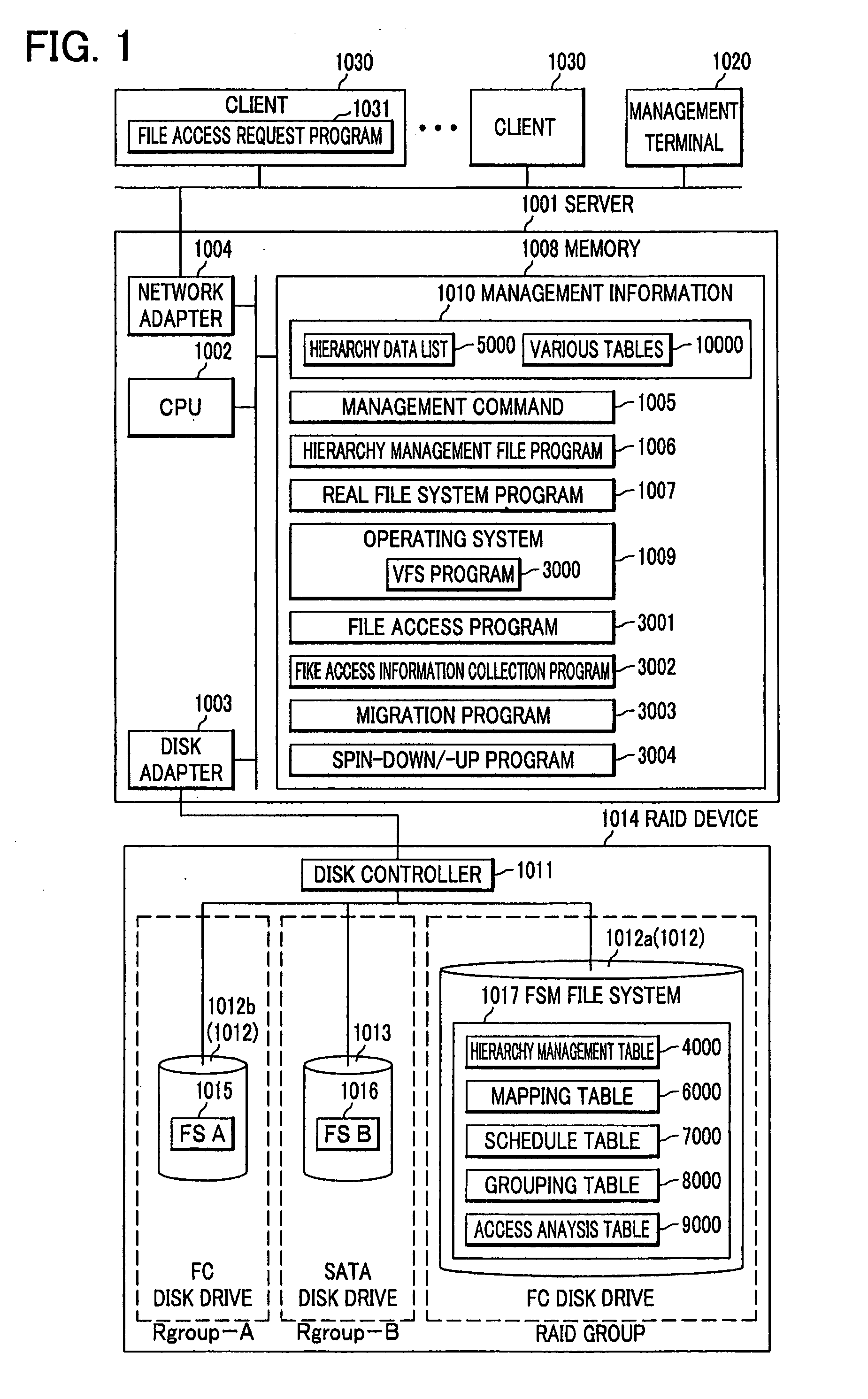File server, file management system and file management method
a file server and file management technology, applied in the field of file system management, can solve the problems of increasing the power consumption of the entire storage, unable to achieve power saving under an environment of continuous file access, and more power consumption for the entire storag
- Summary
- Abstract
- Description
- Claims
- Application Information
AI Technical Summary
Problems solved by technology
Method used
Image
Examples
embodiment 1
[0041]FIG. 1 shows a configuration of a file management system according to the present invention. A hierarchical management file system includes a server 1001 (file server), a RAID (Redundant Arrays of Independent Disks) device 1014 coupled with the server 1001, a management terminal 1020 and a client 1030. The server 1001 and the RAID device 1014 are coupled with each other via a SAN (Storage Area Network), for example. The management terminal 1020, the client 1030 and the server 1001 are coupled with one another via LAN (Local Area Network) for example. The management terminal 1020 may be a computer equivalent to the client 1030.
[0042]The server 1001 is a computer including a CPU (Central Processing Unit: controller) 1002 that executes programs stored on a memory (memory device) 1008, a disk adapter 1003 used for communication with the RAID device 1014, a network adapter 1004 used for communication with the management terminal 1020 and the client 1030, and the memory 1008 that st...
embodiment 2
[0218]In Embodiment 1, since files are classified and migrated based on the file access states, files having a similar access attribute are likely to be concentrated on a single RAID group or LU. Therefore, frequent accesses made on part or all of those files may cause a problem of performance, such as a performance bottleneck.
[0219]To address this shortage, FC (Fiber Channel) paths (ports) used for coupling the RAID groups that have been spun-down with the NAS device (server 1001) are temporarily distributed to the RAID groups being operated (being spun-up) so as to avoid such a performance bottle neck due to the concentrated file accesses.
[0220]Specifically, on the schedule table 7000, there may be provided fields for storing conditions for FC paths distribution as well as names of RAID groups which will be destinations of the FC paths distribution (e.g. every RAID group (in operation) except for the RAID groups of interest). One example of the above conditions may be such that fr...
embodiment 3
[0222]Since the schedule defined on the schedule table 7000 of Embodiment 1 is created based on the statistical processes of the file access information, file accesses may occur even during the stop time period defined on the schedule. Therefore, spin-down operation may cause time delay so that power saving cannot effectively be realized. In order to achieve a desired power saving, it is necessary to offset increase of power consumption due to the spin-down time delay, thus, spin-up time delay should be intentionally made in a next file access, for example.
[0223]To address this shortage, it is controlled to proportionally distribute the spin-up delay time to each RAID group. At this time, each RAID group has its importance defined by its operational reason, therefore, it may be preferable to distribute the spin-up time delay to each RAID group in, proportion to its importance, for example. As a specific example, if 500 second time delay occurs in a certain RAID group, this time dela...
PUM
 Login to View More
Login to View More Abstract
Description
Claims
Application Information
 Login to View More
Login to View More - R&D
- Intellectual Property
- Life Sciences
- Materials
- Tech Scout
- Unparalleled Data Quality
- Higher Quality Content
- 60% Fewer Hallucinations
Browse by: Latest US Patents, China's latest patents, Technical Efficacy Thesaurus, Application Domain, Technology Topic, Popular Technical Reports.
© 2025 PatSnap. All rights reserved.Legal|Privacy policy|Modern Slavery Act Transparency Statement|Sitemap|About US| Contact US: help@patsnap.com



